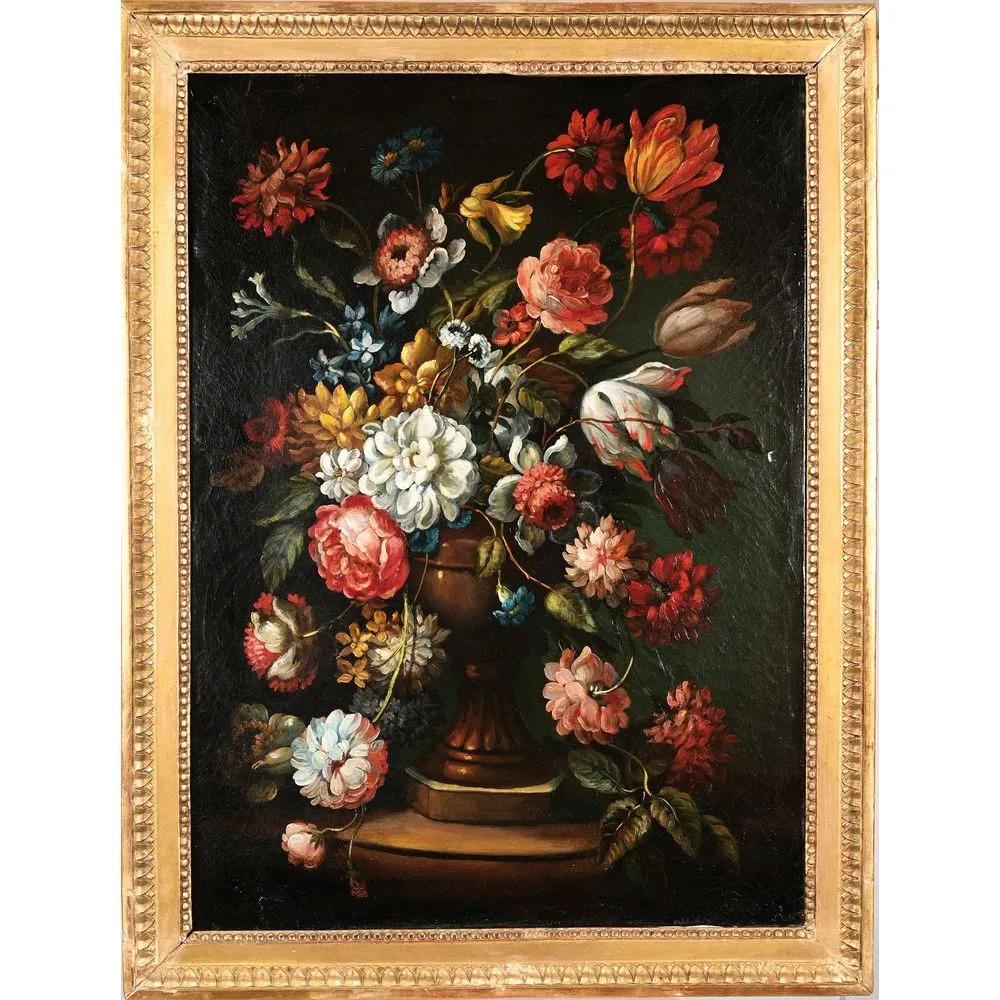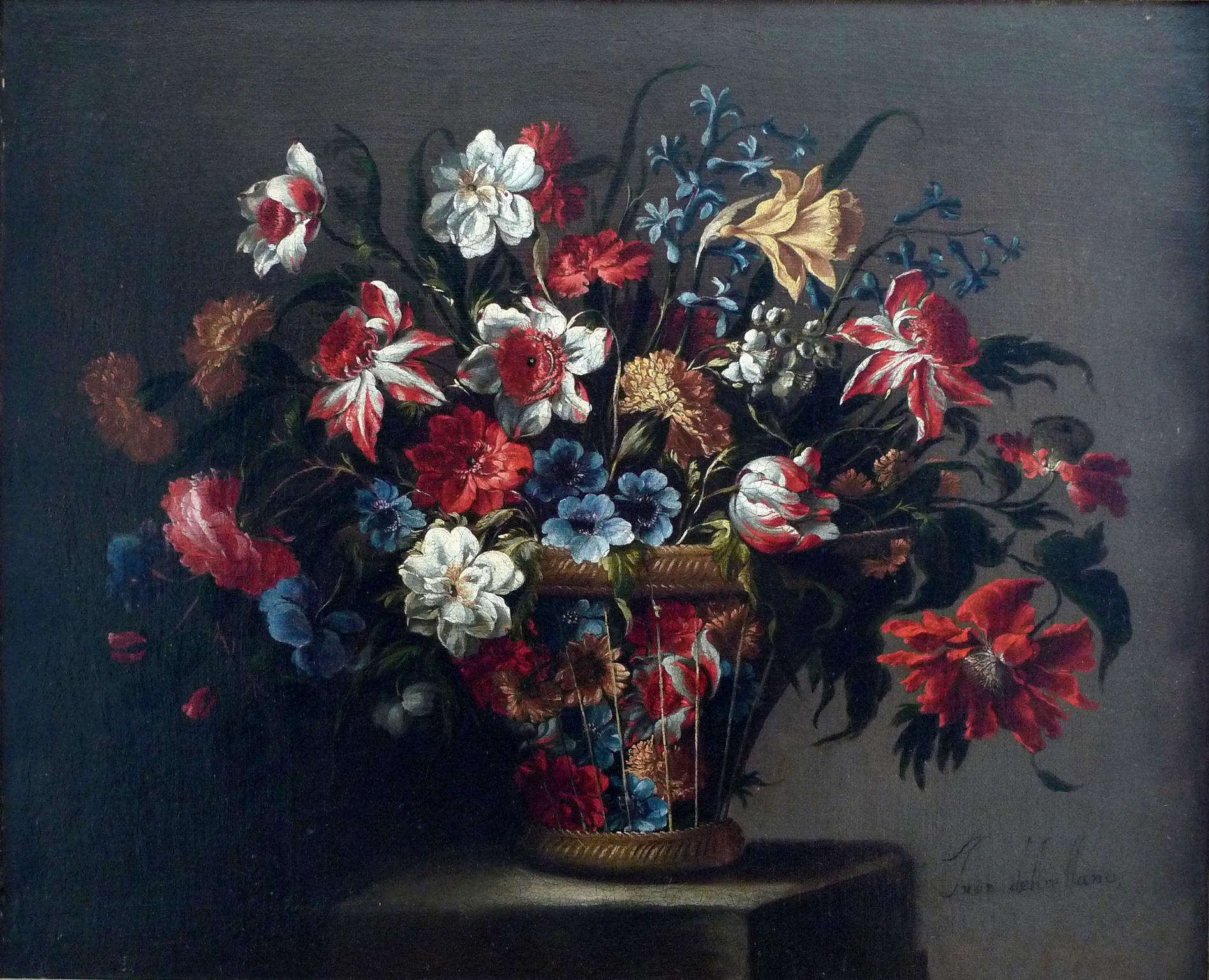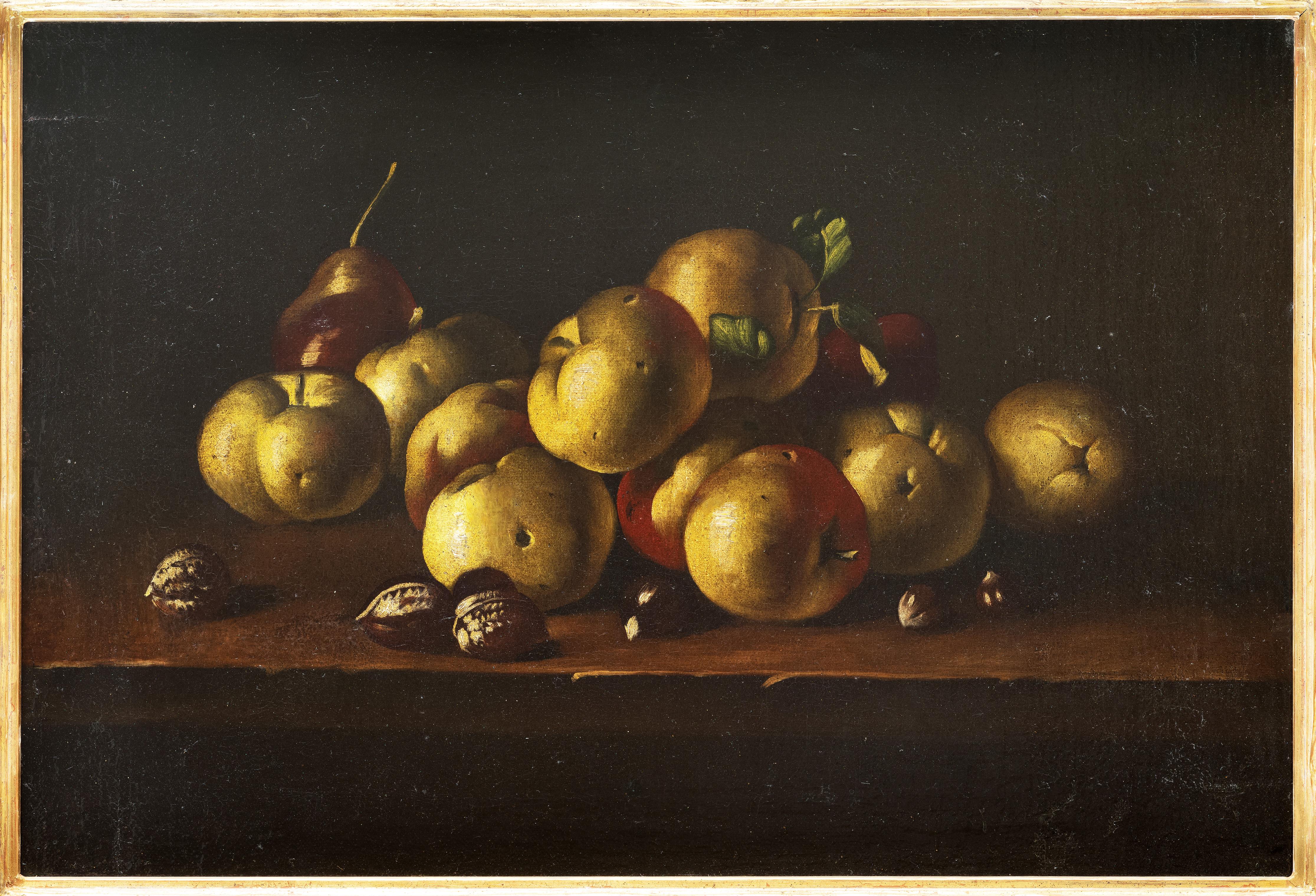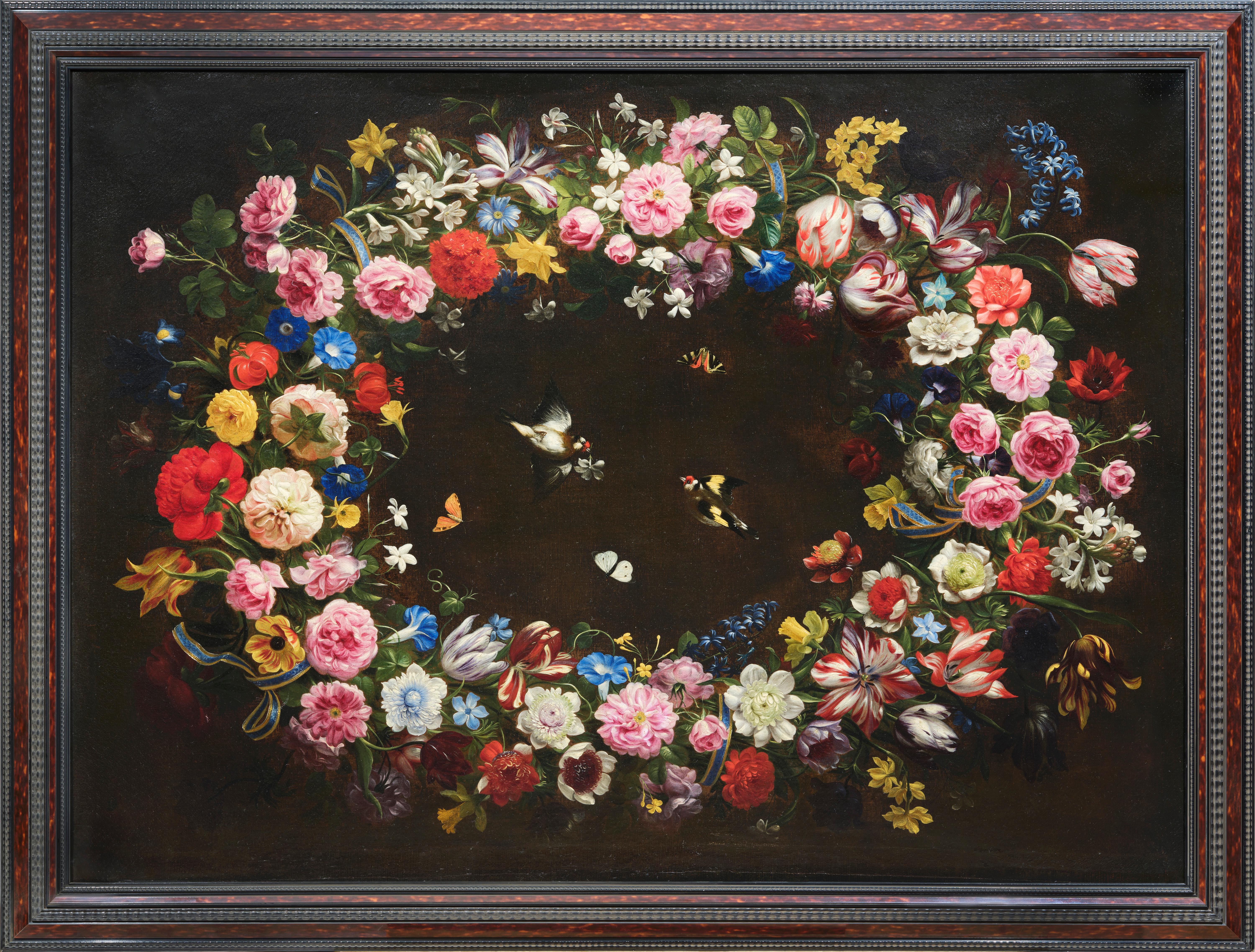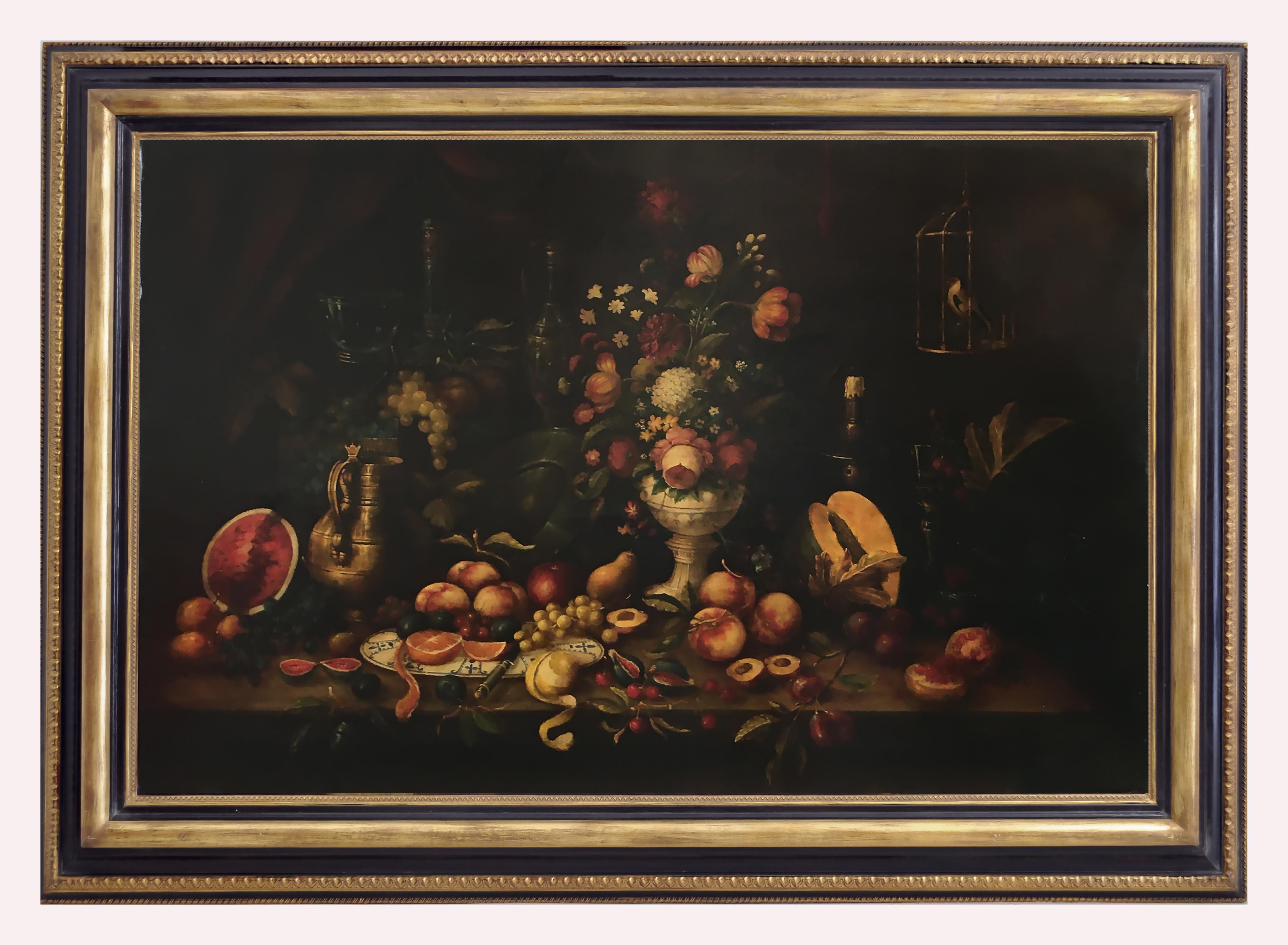Items Similar to Late 17th Century By Still-life Italian painter Still life Oil on Canvas
Want more images or videos?
Request additional images or videos from the seller
1 of 8
Still-life Italian painter of the late 17th century Late 17th Century By Still-life Italian painter Still life Oil on Canvas17th Century
17th Century
About the Item
58 x 136 cm without frame, 71.5 x 150 cm with frame
Antique shaped and gilded wooden box frame
Publications: unpublished
This beautiful painting shows a varied still life with various specimens of game, including hares and birds, juxtaposed with vines, pomegranates and numerous mushrooms. On the latter rests, almost as a lookout, a partridge observing the scene with an alert attitude. The elegant composition created reveals an autumnal flavour of hunting and the first fruits of the undergrowth.
- Creator:Still-life Italian painter of the late 17th century (Italian)
- Creation Year:17th Century
- Dimensions:Height: 22.84 in (58 cm)Width: 53.55 in (136 cm)
- More Editions & Sizes:58 x 136 cm without frame, 71,5 x 150 with framePrice: $12,427
- Medium:
- Movement & Style:
- Period:
- Condition:
- Gallery Location:Milano, IT
- Reference Number:1stDibs: LU1701214248682
About the Seller
5.0
Vetted Seller
These experienced sellers undergo a comprehensive evaluation by our team of in-house experts.
Established in 1964
1stDibs seller since 2021
Typical response time: 13 hours
- ShippingRetrieving quote...Ships From: Milano, Italy
- Return PolicyA return for this item may be initiated within 14 days of delivery.
More From This SellerView All
- 17th Century By Lombard Artist Still Life with Birds and Burning Fuse Oil/canvasLocated in Milano, Lombardia"Cassetta" frame in sculpted, carved, gilded wood. Expertise by Gianluca Bocchi.Category
17th Century Old Masters Still-life Paintings
MaterialsCanvas, Oil
- 17th century By Dutch maestro Still life with bird, carp & lobster Oil on canvasLocated in Milano, LombardiaThis painting fits well into the Dutch pictorial production of the Golden century. The composition, built on the harmonious presentation of rich wild game and fine details such as th...Category
17th Century Old Masters Still-life Paintings
MaterialsCanvas, Oil
- 17th Century by Nicolas van Houbraken Still Life with Mushrooms Oil on CanvasLocated in Milano, LombardiaNicolas Van Houbraken (Messina, 1668 - Pisa, 1733) Still life with mushrooms Oil on canvas, cm. 26 x 32 - with frame cm. 38,5 x 33,5 Antique cassetta frame made of carved wood and ...Category
17th Century Old Masters Still-life Paintings
MaterialsCotton Canvas, Canvas, Oil
- 17th Century by Giovanni Paolo Castelli Still Life Oil on CanvasBy Giovanni Paolo Castelli detto SpadinoLocated in Milano, LombardiaGiovanni Paolo Castelli called Spadino (Rome 1659 - Rome 1730) Still life Oil on canvas, cm. 81x31 - with frame cm. 92x41 Shaped and gilded wo...Category
Late 17th Century Old Masters Still-life Paintings
MaterialsCanvas, Cotton Canvas, Oil
- 18th Century by Francesco Lavagna Pair of Flower Vases Oil on CanvasLocated in Milano, Lombardia98 x 36 cm each without frame - 112 x 50 cm with frame Antique gilded and shaped wooden box frames Expertise by Prof. Giancarlo Sestieri This marvellous pair of flower vases has b...Category
Early 18th Century Old Masters Figurative Paintings
MaterialsCanvas, Oil
- 17th Century by Neapolitan Maestro Still Life with Cuttlefish Oil on CanvasLocated in Milano, LombardiaAntique shaped and gilded wooden box frame. Dimensions: without frame cm. 48.5 x 63 - with frame cm. 59 x 73.5 This beautiful oil painting comes from the Neapolitan still-life prod...Category
17th Century Old Masters Still-life Paintings
MaterialsOil, Canvas
You May Also Like
- École flamande du XVIIIe sLocated in ROUEN, FRSuiveur De Cornelis De Heem (1631-1695) Bouquet de fleurs dans un vase, huile sur toile. 69x56,5 cmCategory
18th Century Old Masters Still-life Paintings
MaterialsCanvas, Oil
- "Cesta de flores", 17th Century Oil on Canvas, Still Flowers by Juan de ArellanoBy Juan de ArellanoLocated in Madrid, ESJUAN DE ARELLANO Spanish, 1614 - 1676 Cesta de Flores signed Juan de Arellano (lower lright) oil on canvas original period carved, gilt and polychrome...Category
17th Century Old Masters Still-life Paintings
MaterialsCanvas, Oil
- A gentleman’s vicesLocated in London, GBEnglish School, circa 1827 A gentleman’s vices the newspaper dated ‘Sunday December 23 1827’ (upper left) oil on canvas 20 ¾ x 24 ½ in. (52.7 x 62.3 cm.) frame 25 ⅝ x 29 ¼ in. (65.1...Category
Early 19th Century Old Masters Still-life Paintings
MaterialsCanvas, Oil
- Still Life with Apples and Nuts, 17th Century, Old Master, Spanish PaintingLocated in Greven, DEJuan Sánchez Cotán (1560 - 1627) was one of the most important still life painters in Spain and beyond. He developed a certain type of still life with a ...Category
17th Century Old Masters Still-life Paintings
MaterialsCanvas, Oil
- Flower Garland by Giovanni Stanchi, the most Flemish Italian flower painterBy Giovanni StanchiLocated in PARIS, FRThis painting is reproduced in the reference book on Roman still life "Pittori di nature morta a Roma - artisti italiani 1630 -1750" by Gianluca and Ulisse Bocchi - Arti Grafiche Castello 2005 (page 250 figure FS5), where it is mentioned as one of the few paintings that can be given with certainty to Giovanni Stanchi. This highly decorative flower garland reveals a very strong Flemish influence, enabling us to attribute it with certainty to Giovanni Stanchi, the eldest of a sibling group of painters active in the production of still lifes in 17th century Rome. Probably painted before 1640, our garland conceals a mystical message beneath its decorative opulence, which we're about to reveal ... 1. Giovanni, Niccolò and Angelo Stanchi, a brotherhood of still-life painters in 17th-century Baroque Rome The three Stanchi brothers, Giovanni (1608 - after 1675), Niccolò (ca. 1623 - 1690) and Angelo (1626 - after 1675) lived and worked together (like the Le Nain brothers), making identification of the different hands perilous. Giovanni Stanchi's name is first mentioned in 1634, in the register of the painters' guild of the "Accademia di San Luca". Paid membership of the painters' guild provided not only a social network, but also commissions from important Roman families. In 1638, Giovanni Stanchi painted a picture for the Barberini family depicting their coat of arms surrounded by flowers. In 1660, he was commissioned by Cardinal Flavio Chigi to decorate a gallery with still lifes of flowers and fruit. The Chigis remained his principal patrons until after 1673. Thereafter, he received commissions from almost every important family in Rome. An invoice dated 1670 identifies Giovanni Stanchi and Mario Nuzzi as the painters responsible for the still lifes that decorated the famous mirrors in Palazzo Colonna. In 1675, Giovanni Stanchi's name appears for the last time in connection with a project in which he was engaged, together with Andries Bosman and the figure painter Ciro Ferri, to decorate the mirrors of the Palazzo Borghese on Campo Marzio. Although all three brothers were active as painters, the records of their commissions always refer to Giovanni, since, as eldest brother, he was responsible for invoices and contracts. Only in a few cases is the name of one of the younger brothers mentioned. Only paintings with a strong Flemish influence dating from the first four decades of the 17th century, such as this one, can be attributed with certainty to Giovanni, as he was the only painter in the family at the time. 2. History of a genre: the flower garland Jan Brueghel the Elder (Brussels 1568 - Antwerp 1625) is credited with inventing the flower garland theme during his stay in Rome in 1592. Such garlands were originally used to surround a religious subject, often a Marian one. This religious scene could sometimes be painted by another artist, as in the painting acquired in 1608 by Cardinal Borromeo, featuring a Madonna (painted by Henry van Balen), surrounded by a garland painted by Jan Brueghel. This theme was taken up and developed in Rome from 1625 onwards by Daniel Seghers, before the young Giovanni Stanchi made it his own, reinforcing its symbolic dimension (to which we shall return) and moving away from the naturalistic approach of Jan Brueghel to develop a certain idealization of each flower, closer to the style of Mario Nuzzi (Rome 1603 - 1673). Giovanni Stanchi's garlands, of which he was the best Italian interpreter in the 17th century, also reveal him to be one of the most faithful to the Flemish tradition. The book by Gianluca and Ulisse Bocchi lists nine still lifes very similar to ours, all executed on a black background (including the one reproduced as the last photo in the gallery, which belongs to the Pinacoteca Nazionale in Bologna). Because of their proximity to Flemish works, they can be attributed with certainty to Giovanni Stanchi. Four of them belong to private collections, while the others are all in public institutions (Anhaltische Gemäldegalerie, Dessau; Galeria del Palazzo Bianco, Genoa; Musée des Beaux-Arts, Bordeaux; Pinacoteca Nazionale, Bologna; Palazzo Chigi-Saraceni, Siena). Like those in Flemish still lifes, the flowers depicted by Giovanni Stanchi bloom at different times of the year, ruling out any representation of a real bouquet. Alongside the more traditional flowers of our gardens (roses, tulips, hyacinths, daffodils, irises), it is also interesting to note the frequent inclusion of more exotic flowers such as jasmine and blue bindweed (ipomoea indica), which had been recently introduced to Europe from Mexico. Each flower painted by Giovanni Stanchi seems to have its own individuality, a trait characteristic of Flemish painting, of which Stanchi was the best interpreter in Italy. One could say that Stanchi does not depict garlands of flowers, but flowers in a garland, each with its own identity and specificity, making it unique and different from the others. Captured in a low-angled light that seems to have captured them for eternity, they are drawn with clear, precise lines. As if they had been freshly cut, they emerge from the darkness in geometric figures that reinforce the tactile quality of their representation. One of Giovanni Stanchi's distinctive features is to have substituted the central religious representation traditionally associated with Flemish flower...Category
17th Century Old Masters Still-life Paintings
MaterialsCanvas, Oil
- Still Life - Italian Oil On Canvas Painting by Antonio JannoneBy ANTONIO JANNONELocated in Napoli, ITStill life - Oil on canvas cm.100x150, Antonio Jannone, Italy, 2003. Frame available on request.Category
Early 2000s Old Masters Still-life Paintings
MaterialsCanvas, Oil
Recently Viewed
View AllMore Ways To Browse
Italy Antique
Late Antique Art
Antique Stills
Beautiful Antique Painting
Beautiful Antique Paintings
Almost Antique
Wooden Art Italian
Antique Still Life
Antique Publications
Antique Italian Oil On Canvas
Antique Italian Still Life
Oil On Canvas 17th Century
Antique Latter
Still Life Game
17th Italian Frame
Italian 17th Century Frame
Italian Painting 17th
17th Century Italian Painting
